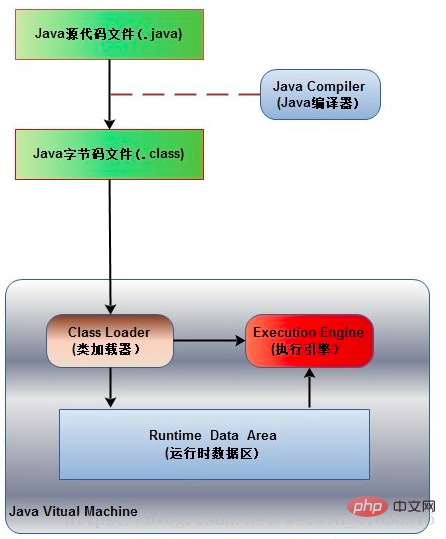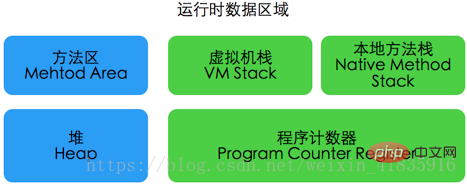
SF interview question: Do you understand the Java memory model?
360 interview question: Distribution of program memory, five parts
(Learning video sharing: java teaching video)
1. The execution process of the java program

The Java source code file (.java suffix) will be compiled into a bytecode file (.class suffix) by the Java compiler, and then used by the JVM The class loader loads the bytecode files of each class. After the loading is completed, it is handed over to the JVM execution engine for execution. During the entire program execution process, the JVM will use a space to store data and related information needed during program execution. This space is generally called the Runtime Data Area, which is what we often call the JVM. Memory. Therefore, the memory management we often talk about in Java is to manage this space (how to allocate and reclaim memory space).
(Recommendations for more related interview questions: java interview questions and answers)
2. What parts does the runtime data area include:

Method Area:
The method area is a memory area shared by each thread. It is used to store class information, constants, and static information that have been loaded by the virtual machine. Variables, code compiled by just-in-time compiler and other data. When the method area cannot meet the memory allocation requirements, an OutOfMemoryError exception will be thrown.
The method area stores the class version, fields, methods, interfaces and constant pools. The constant pool stores literal and symbolic references. Symbol references include: 1. Fully qualified name of the class, 2. Field names and attributes, 3. Method names and attributes.
JVM Heap (Java Heap):
The Java heap is also a memory area shared by threads. It is created when the virtual machine starts and is managed by the Java virtual machine. The largest piece of memory, mainly used to store object instances. Almost all object instances allocate memory here. Note that the Java heap is the main area managed by the garbage collector, so it is often called the GC heap. If it is in the heap When no memory is available for instance allocation and the heap cannot be expanded, an OutOfMemoryError exception is thrown.
Program Counter Register:
When the bytecode interpreter is working, it selects the next bytecode that needs to be executed by changing the value of this counter. Instructions, branches, loops, jumps, exception handling, thread recovery and other basic functions all need to rely on this counter to complete.
In multi-threading, in order to restore the correct execution position after thread switching, each thread needs to have an independent program counter. Each thread does not affect each other and is stored independently. Therefore, this memory is a thread private.
Virtual machine stack (Java Virtual Machine Stacks):
The Java virtual machine stack is also private to the thread, and its life cycle is the same as the thread. The virtual machine stack describes the memory model of Java method execution: when each method is executed, a stack frame is created to store local variable tables, operand stacks, dynamic linked lists, method exit information, etc. The process from the call to the completion of execution of each method corresponds to the process from pushing a stack frame into the virtual machine stack to popping it out.
Native Method Stacks:
The local method stack belongs to the thread private data area. This part is mainly related to the Native methods used by the virtual machine. Normally, we don't need to care about this area.
(Related recommendations: java introductory tutorial)
The above is the detailed content of Java interview memory model. For more information, please follow other related articles on the PHP Chinese website!

Hot AI Tools

Undress AI Tool
Undress images for free

Undresser.AI Undress
AI-powered app for creating realistic nude photos

AI Clothes Remover
Online AI tool for removing clothes from photos.

Clothoff.io
AI clothes remover

Video Face Swap
Swap faces in any video effortlessly with our completely free AI face swap tool!

Hot Article

Hot Tools

Notepad++7.3.1
Easy-to-use and free code editor

SublimeText3 Chinese version
Chinese version, very easy to use

Zend Studio 13.0.1
Powerful PHP integrated development environment

Dreamweaver CS6
Visual web development tools

SublimeText3 Mac version
God-level code editing software (SublimeText3)
 How to handle transactions in Java with JDBC?
Aug 02, 2025 pm 12:29 PM
How to handle transactions in Java with JDBC?
Aug 02, 2025 pm 12:29 PM
To correctly handle JDBC transactions, you must first turn off the automatic commit mode, then perform multiple operations, and finally commit or rollback according to the results; 1. Call conn.setAutoCommit(false) to start the transaction; 2. Execute multiple SQL operations, such as INSERT and UPDATE; 3. Call conn.commit() if all operations are successful, and call conn.rollback() if an exception occurs to ensure data consistency; at the same time, try-with-resources should be used to manage resources, properly handle exceptions and close connections to avoid connection leakage; in addition, it is recommended to use connection pools and set save points to achieve partial rollback, and keep transactions as short as possible to improve performance.
 How to work with Calendar in Java?
Aug 02, 2025 am 02:38 AM
How to work with Calendar in Java?
Aug 02, 2025 am 02:38 AM
Use classes in the java.time package to replace the old Date and Calendar classes; 2. Get the current date and time through LocalDate, LocalDateTime and LocalTime; 3. Create a specific date and time using the of() method; 4. Use the plus/minus method to immutably increase and decrease the time; 5. Use ZonedDateTime and ZoneId to process the time zone; 6. Format and parse date strings through DateTimeFormatter; 7. Use Instant to be compatible with the old date types when necessary; date processing in modern Java should give priority to using java.timeAPI, which provides clear, immutable and linear
 Comparing Java Frameworks: Spring Boot vs Quarkus vs Micronaut
Aug 04, 2025 pm 12:48 PM
Comparing Java Frameworks: Spring Boot vs Quarkus vs Micronaut
Aug 04, 2025 pm 12:48 PM
Pre-formanceTartuptimeMoryusage, Quarkusandmicronautleadduetocompile-Timeprocessingandgraalvsupport, Withquarkusoftenperforminglightbetterine ServerLess scenarios.2.Thyvelopecosyste,
 Understanding Network Ports and Firewalls
Aug 01, 2025 am 06:40 AM
Understanding Network Ports and Firewalls
Aug 01, 2025 am 06:40 AM
Networkportsandfirewallsworktogethertoenablecommunicationwhileensuringsecurity.1.Networkportsarevirtualendpointsnumbered0–65535,withwell-knownportslike80(HTTP),443(HTTPS),22(SSH),and25(SMTP)identifyingspecificservices.2.PortsoperateoverTCP(reliable,c
 How does garbage collection work in Java?
Aug 02, 2025 pm 01:55 PM
How does garbage collection work in Java?
Aug 02, 2025 pm 01:55 PM
Java's garbage collection (GC) is a mechanism that automatically manages memory, which reduces the risk of memory leakage by reclaiming unreachable objects. 1.GC judges the accessibility of the object from the root object (such as stack variables, active threads, static fields, etc.), and unreachable objects are marked as garbage. 2. Based on the mark-clearing algorithm, mark all reachable objects and clear unmarked objects. 3. Adopt a generational collection strategy: the new generation (Eden, S0, S1) frequently executes MinorGC; the elderly performs less but takes longer to perform MajorGC; Metaspace stores class metadata. 4. JVM provides a variety of GC devices: SerialGC is suitable for small applications; ParallelGC improves throughput; CMS reduces
 Comparing Java Build Tools: Maven vs. Gradle
Aug 03, 2025 pm 01:36 PM
Comparing Java Build Tools: Maven vs. Gradle
Aug 03, 2025 pm 01:36 PM
Gradleisthebetterchoiceformostnewprojectsduetoitssuperiorflexibility,performance,andmoderntoolingsupport.1.Gradle’sGroovy/KotlinDSLismoreconciseandexpressivethanMaven’sverboseXML.2.GradleoutperformsMaveninbuildspeedwithincrementalcompilation,buildcac
 go by example defer statement explained
Aug 02, 2025 am 06:26 AM
go by example defer statement explained
Aug 02, 2025 am 06:26 AM
defer is used to perform specified operations before the function returns, such as cleaning resources; parameters are evaluated immediately when defer, and the functions are executed in the order of last-in-first-out (LIFO); 1. Multiple defers are executed in reverse order of declarations; 2. Commonly used for secure cleaning such as file closing; 3. The named return value can be modified; 4. It will be executed even if panic occurs, suitable for recovery; 5. Avoid abuse of defer in loops to prevent resource leakage; correct use can improve code security and readability.
 Using HTML `input` Types for User Data
Aug 03, 2025 am 11:07 AM
Using HTML `input` Types for User Data
Aug 03, 2025 am 11:07 AM
Choosing the right HTMLinput type can improve data accuracy, enhance user experience, and improve usability. 1. Select the corresponding input types according to the data type, such as text, email, tel, number and date, which can automatically checksum and adapt to the keyboard; 2. Use HTML5 to add new types such as url, color, range and search, which can provide a more intuitive interaction method; 3. Use placeholder and required attributes to improve the efficiency and accuracy of form filling, but it should be noted that placeholder cannot replace label.






